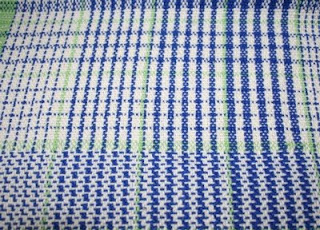We enjoyed a few days of Autumn sunshine last week (wonderful, after a wet, grey Summer!) so one fine afternoon I took my samplers outside where the light was good and took a few photos.

This is a close up of a plain weave section...
 ...and here's a close-up of twill. The warp yarn on the left of the picture is yellow, and on the right, orange. Orange and pink (top right) is not a combination I would have chosen before weaving this, but it works remarkably well. See how much warmer the colours with pink weft (top) are than those with the light blue (below), and that's inspite of this being a dull, blue-ish pink. The yellow warp lifts the tone of the pink, with orange it is more dull in tone and the right hand side receeds against the yellow. Look again and see how there is (left versus right) light and shadow, near and far.
...and here's a close-up of twill. The warp yarn on the left of the picture is yellow, and on the right, orange. Orange and pink (top right) is not a combination I would have chosen before weaving this, but it works remarkably well. See how much warmer the colours with pink weft (top) are than those with the light blue (below), and that's inspite of this being a dull, blue-ish pink. The yellow warp lifts the tone of the pink, with orange it is more dull in tone and the right hand side receeds against the yellow. Look again and see how there is (left versus right) light and shadow, near and far. Here we see the same weft colours with totally different section of warp, something reminiscent of pink Foxgloves (top) or blue Forget-me-not (below)?
Here we see the same weft colours with totally different section of warp, something reminiscent of pink Foxgloves (top) or blue Forget-me-not (below)? The same green warp with colours similar to the above, but different effect, cooler tones.
The same green warp with colours similar to the above, but different effect, cooler tones. Selection of greens:
Selection of greens:
My favourite red/orange/yellows:
 Colours of spring moorland, grass, reeds and heather:
Colours of spring moorland, grass, reeds and heather:
The two different samplers examined together, same two yarns warp and weft in diagonal twill and in plain weave.
 And also:
And also:
Folding the plain weave sampler enables me to show you, left of picture, the blue-jade yarn warp and weft, centre with a white warp and right with navy blue. Don't you think that the blue-jade colour looks paler with white, and blue against the navy? So much of our perception of colour depends on context. (no, the colours didn't run in the wash!)







































